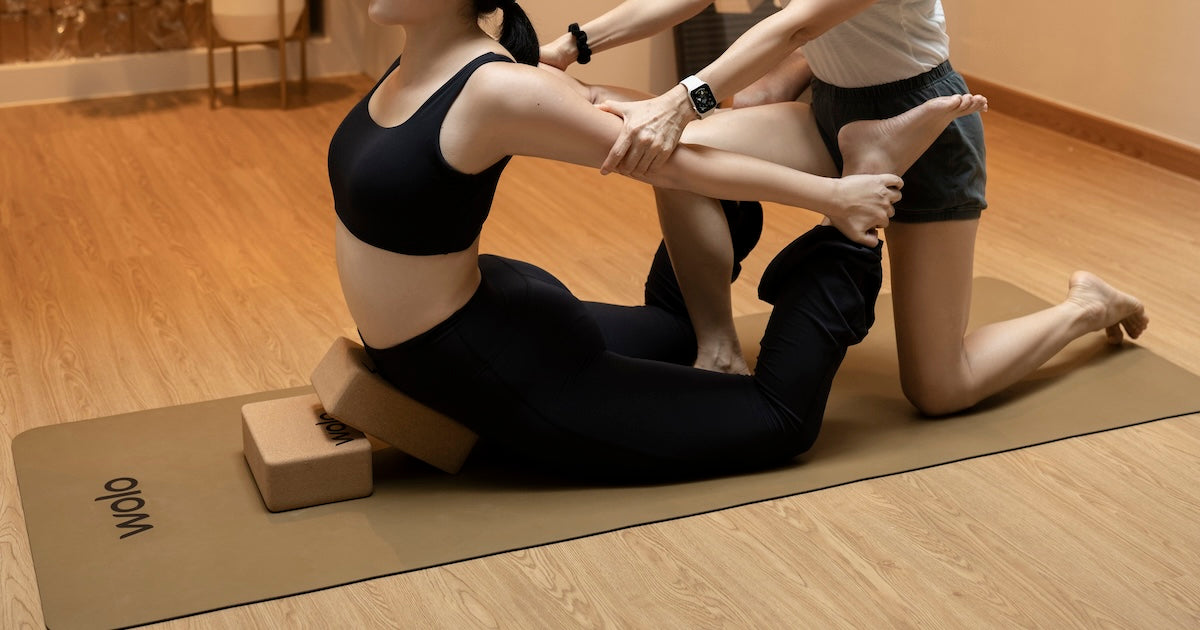Just like you shower after a good workout, your yoga mat needs a clean to keep it free from dirt and bacteria that love to make it their home.
Whether you're a seasoned yogi or just starting out, understanding how to clean your yoga mat properly will enhance your practice by creating a clean and positive space for your yoga journey.
Understanding the importance of yoga mat hygiene
Regularly cleaning your yoga mat is crucial for several reasons. First, it helps prevent the buildup of dirt, oils, and sweat, which can make your mat slippery and unsafe. Secondly, a clean mat is essential to maintain your health. Dirty yoga mats can harbor bacteria, fungi, and viruses that can cause skin infections, athlete's foot, and more.
If you neglect yoga mat hygiene, you're exposing yourself to potential health risks every time you practice. Your mat absorbs all the sweat, oils, and dead skin cells, creating a breeding ground for microorganisms. This can lead to skin irritations and infections, disrupting your yoga practice and overall well-being.

Moreover, a well-maintained yoga mat can last longer, saving you money in the long run and reducing environmental waste. Cleanliness supports a focused and uninterrupted practice, allowing you to connect better with your yoga journey.
Before you start cleaning your yoga mat
Before cleaning a yoga mat, it's important to know what type you have, as different materials require different care. Most mats will have care instructions included at the time of purchase, so be sure to check those first. Generally, there are rubber, PVC, TPE, and cotton mats, each requiring a specific approach to cleaning.
The tools and equipment you'll need for cleaning your yoga mat include a soft cloth or sponge, a gentle cleaning solution (which can be made at home or bought from a store), and water. For drying, you'll need enough space to lay your mat flat or hang it up without folding over or crimping.
Identifying your mat's material is crucial because yoga mats absorb different amounts of water and cleaning solutions, affecting how you should approach cleaning them. Rubber mats, for example, are more porous and can absorb more soap, requiring thorough rinsing.
The ultimate yoga mat cleaning solution
Whether you're mixing a DIY cleaner or choosing a store-bought one, the goal is to find a solution that effectively cleans without damaging your mat. A gentle, non-abrasive cleaner will ensure your mat stays in top condition for your next yoga session.
How to make your own DIY yoga mat cleaner
Making your own yoga mat cleaner is easy and cost-effective. All you need is water and white vinegar, which has natural antimicrobial properties. Then, mix one part vinegar with four parts water in a spray bottle. While it's optional, you can also add a teaspoon of baking soda into the solution.

To use your DIY cleaner, simply spray the solution onto your mat and wipe it down with a microfiber towel. This method uses natural ingredients, making it a safe and environmentally friendly option for keeping your yoga mat clean and fresh.
Exploring store-bought solutions for yoga mat care
If DIY isn't your thing, there are plenty of effective store-bought cleaners specifically designed for yoga mats. Look for options that list natural ingredients and avoid harsh chemicals to ensure they won't degrade your mat's material over time.
When selecting a cleaner, consider the type of yoga mat materials you have and choose a solution that's compatible. Always follow the instructions on the bottle, and after cleaning, allow your mat to air dry completely before rolling it up again.
Routine cleaning methods: Keeping your mat fresh
For routine cleaning, a quick wipe down with your preferred yoga mat cleaner after each practice can keep your mat fresh and extend its life. Remember to rinse it thoroughly to remove any cleaner residue.
Quick, post-class cleaning
After a yoga session, it's a good idea to clean your mat to remove sweat and oils quickly. As mentioned above, a simple solution is to mix water with white vinegar in a spray bottle. This mix can be lightly sprayed over your mat and wiped down with a clean towel. The white vinegar helps keep the yoga mat materials clean and fresh without damaging them.
For an even quicker option, keep pre-moistened wipes or a small towel and a spray bottle of your cleaner in your yoga bag for an easy clean-up right after class. This habit ensures you're always practicing on a clean surface.
Deep-clean a yoga mat
For deeper cleans, especially when dealing with tough stains or odors, soaking your mat in a bathtub with warm water and a mild detergent can work wonders. Allow it to soak for 10 to 15 minutes, then gently scrub with a soft brush or cloth to remove any stubborn dirt.
Afterward, rinse the mat thoroughly and roll it up in a towel to squeeze out excess water. Then, lay the mat flat to dry on a clean surface or hang it on a drying rack, ensuring it's completely dry before rolling or storing to prevent mold and mildew growth.
However, depending on the materials, this deep cleaning method doesn't work for all yoga mats. So always check and follow the cleaning instructions the yoga mat brand provides.
How often should you clean a yoga mat?
Cleaning your yoga mat regularly is key to a hygienic practice. Aiming to clean your yoga mat once a week is a good baseline, but if you're practicing yoga daily or have a history of skin issues, you might want to clean it more frequently. Natural cleaning solutions can help maintain the mat's integrity while keeping it fresh.
Signs that it's time to give your mat a deeper clean include an odor or visible dirt. Always allow your mat to dry completely before rolling it up to prevent bacteria and mold growth. Laying the mat flat to dry on a flat surface or hanging it over a drying rack ensures air circulates around the entire mat, speeding up the drying process.
Is putting your yoga mat in the washing machine safe?
Some yoga mats are machine washable, which can be a convenient way to disinfect your yoga mat. If your mat is machine washable, use a gentle cycle with mild detergent and air dry it afterward. However, hand washing is often recommended to extend the life of your mat.
Always check the care instructions provided with your yoga mat before attempting to machine wash it. If in doubt, hand washing with natural mat cleaner and water is the safest cleaning method. This ensures your mat stays in good shape, ready for your next downward dog.
Post-cleaning care: Drying and storage tips
After you clean your yoga mat, drying it properly is crucial to prevent mold and bad smells. The best way to dry your mat is to hang it over a sturdy shower or shower curtain rod. This allows air to circulate around the mat, speeding up the drying process. Make sure the room is well-ventilated to help moisture evaporate faster. Avoid leaving your damp yoga mat rolled up, as this can create a breeding ground for bacteria.
Once your yoga mat is completely dry, roll it up loosely and store it in a cool, dry place. Avoid putting heavy objects on top of it, as this can damage the mat's structure and surface. If you have a yoga mat bag, use it only when the mat is dry to keep it clean and protected between uses. Proper storage helps maintain the mat's integrity and ensures it's ready for your next yoga session.
How to keep your mat clean for longer
To keep your yoga mat clean longer, consider using a yoga towel during your sessions. A yoga towel absorbs sweat and provides additional protection against dirt and oils from your skin. This keeps your mat cleaner and extends its life by reducing wear and tear. After each yoga session, simply wash the yoga towel, which is much easier than cleaning the mat itself frequently.

Another effective strategy is to gently wipe down your yoga mat with a damp cloth after each use. You can also spray a few disinfection cleaning sprays mentioned above. This quick cleaning method helps to maintain a hygienic surface and prevent the buildup of germs and odors, which is especially important if you attend public yoga classes where mats are often shared.
Final thoughts on yoga mat care and maintenance
Caring for your yoga mat involves more than just occasional cleaning. Using mild natural cleaner and water for a gentle yet effective clean can make a significant difference. Remember to dry your mat completely before rolling it up for storage.
Regular maintenance, including quick post-class wipes and periodic deep cleaning, will keep your yoga mat in top condition. Paying attention to how you store your mat—preferably in a cool, dry place, away from direct sunlight—will further protect it from wear and tear.
By following these simple care tips, you can ensure your yoga mat remains a clean, safe, and comfortable space for your practice for years to come.




